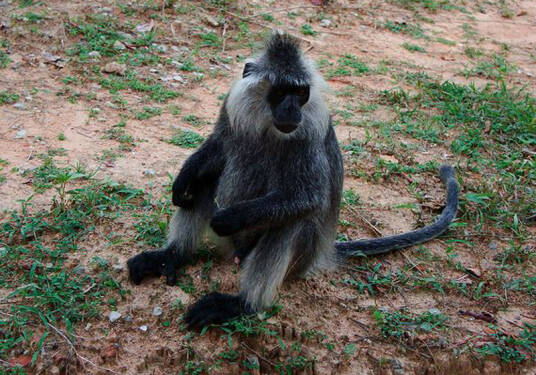Trachypithecus germaini
IUCN
LCBasic Information
Scientific classification
- name:Trachypithecus germaini
- Scientific Name:Trachypithecus germaini,Indochinese Lutung,Germanic langur, Indonesian langur
- Outline:Primates
- Family:Monkey genus
Vital signs
- length:49-59cm
- Weight:About 8kg
- lifetime:About 20 years
Feature
Has a black face surrounded by long gray-white hair
Distribution and Habitat
Distributed in southeastern Thailand, west of the Mekong River in Cambodia, southern Vietnam, Myanmar and southern Laos.
It lives in tropical and subtropical areas with lush forests, thick shrubs, steep mountains and limestone areas with many caves.
Appearance
The head and body length of the Indochinese black leaf monkey is 49-59 cm, and the tail length is 72-84 cm. It is a long-tailed arboreal monkey with a slender body, a small head, a slender tail and limbs, black to medium gray upper body, and slightly lighter color of the lower body fur. The head has short black hair and looks like a small grizzly bear. The four toes are black, the forearms are dark gray, the upper surface of the tail is black and slightly lighter below, and the face is black, surrounded by long gray-white hair, forming a unique "halo". There is a short and pointed hair crown on the top of the head, with a prominent brow ridge and permanent eyebrows. They spend most of their time in trees, using their tails to balance their bodies when jumping. Female monkeys have whitish pubic hair.
Compared with adult monkeys, the body color of newborn cubs is orange or milky white, and the ears, face, hands and feet are all pink, which forms a strong contrast with the gr
Details
Indochinese black leaf monkey (scientific name: Trachypithecus germaini) foreign name Indochinese Lutung, no subspecies.

Indochinese black leaf monkey likes to live in groups, in small groups, each group usually has 3-10 individuals. Mainly arboreal, usually active and foraging in the upper layers of trees, rarely going to the ground, with a certain activity pattern and a relatively fixed residence. Led by a male monkey, they forage in the morning and afternoon and rest at noon. They sleep in trees or caves at night. They are herbivorous primates, and their main food is leaves, flower buds, buds and flowers, wild fruits and seeds. They occasionally eat insects and other small animals.
Detailed information on the social and reproductive behavior of the Indochinese black leaf monkey is lacking, but it is likely that, like other related species, they live in small groups consisting of a single adult male and give birth to a baby monkey every two years.
The Indochinese black leaf monkey was once a relatively widespread species, but it has become very rare in most of its original range, and the species is thought to have declined by more than half in the decades since the 1970s. The main threats to the species are hunting, food, medicine and pet trade, and habitat loss, mainly due to agricultural development.
The Indochinese langur lives in many protected areas, including Phu Quoc National Park and Cat Tien National Park in Vietnam and Phnom Samkos Wildlife Sanctuary in Cambodia. The species is regulated in international trade and is protected by law in Vietnam, with strong enforcement of the law, and other measures are urgently needed to control hunting and wildlife trade. Increased environmental education and the development of sustainable alternatives to forest destruction are also proposed to protect the primates in the area.
Listed on the IUCN Red List of Threatened Species in 2008 ver 3.1 - Endangered (EN).
Listed in the CITES Appendix II protected animals of the Washington Convention.
Protect wild animals and eliminate game.
Maintaining ecological balance is everyone's responsibility!








